Don't wanna be here? Send us removal request.
Text
How to Create Temp Table in SQL
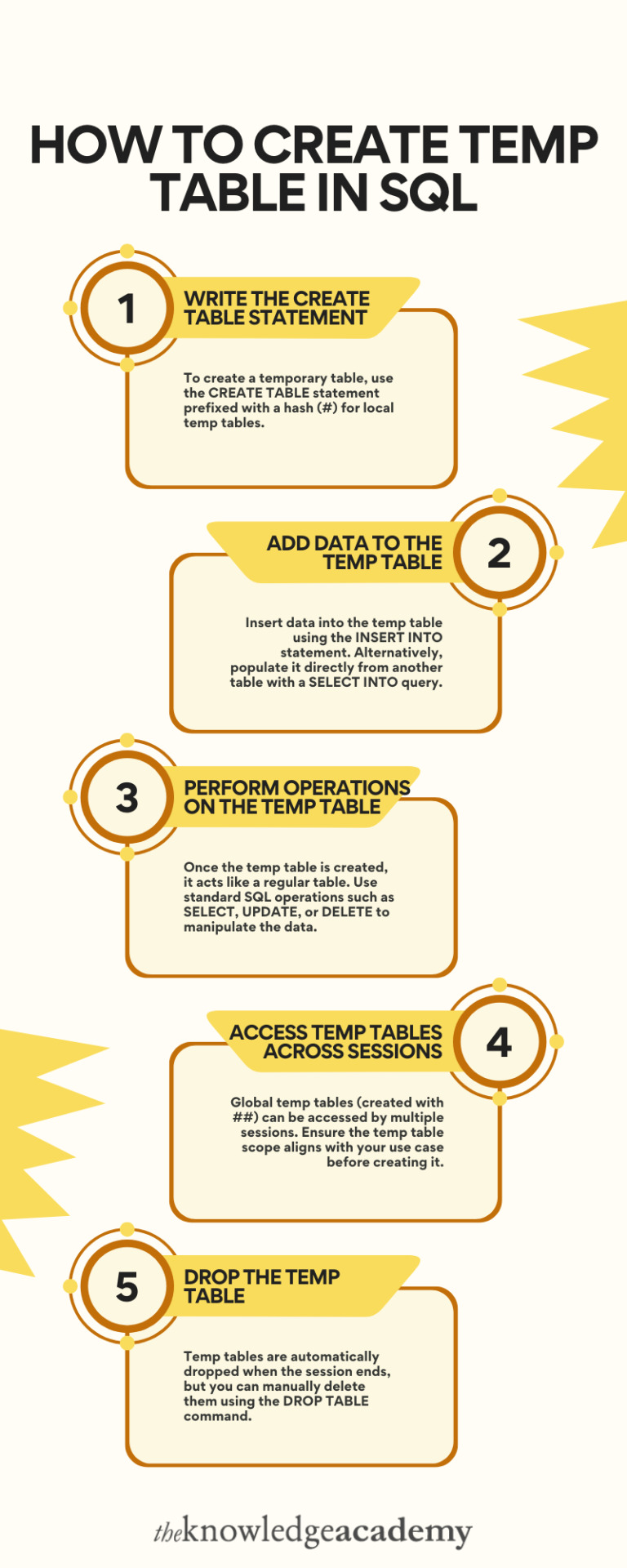
Knowing How to Create Temp Tables in SQL is essential for managing temporary data storage during query execution. To begin, use the CREATE TABLE statement with a hash symbol (#) to create local temp tables. For global accessibility across multiple sessions, prefix the table name with double hashes (##). Data can be added to temp tables using INSERT INTO or directly populated with a SELECT INTO query, depending on the source and requirements. These temp tables allow you to perform SQL operations like SELECT, UPDATE, and DELETE, just like permanent tables. Once their purpose is served, temp tables are dropped automatically at the end of the session or can be removed manually using the DROP TABLE command. They are invaluable for simplifying query logic, improving performance, and structuring complex workflows. Learning how to create and use temp tables effectively can greatly enhance your database management skills. Consider The Knowledge Academy courses to advance your SQL expertise.
0 notes
Text
How to Enhance Your Natural Beauty

In a world full of Makeup Brands and beauty trends, sometimes the best look is simply enhancing what you already have. Embracing your natural beauty is about highlighting your best features without heavy layers of product. In this guide, we’ll share tips and techniques to enhance your natural glow, using simple routines and just the right products. Discover how a little can go a long way in showcasing your true beauty.
0 notes
Text
8 Steps for Attracting Top Talent
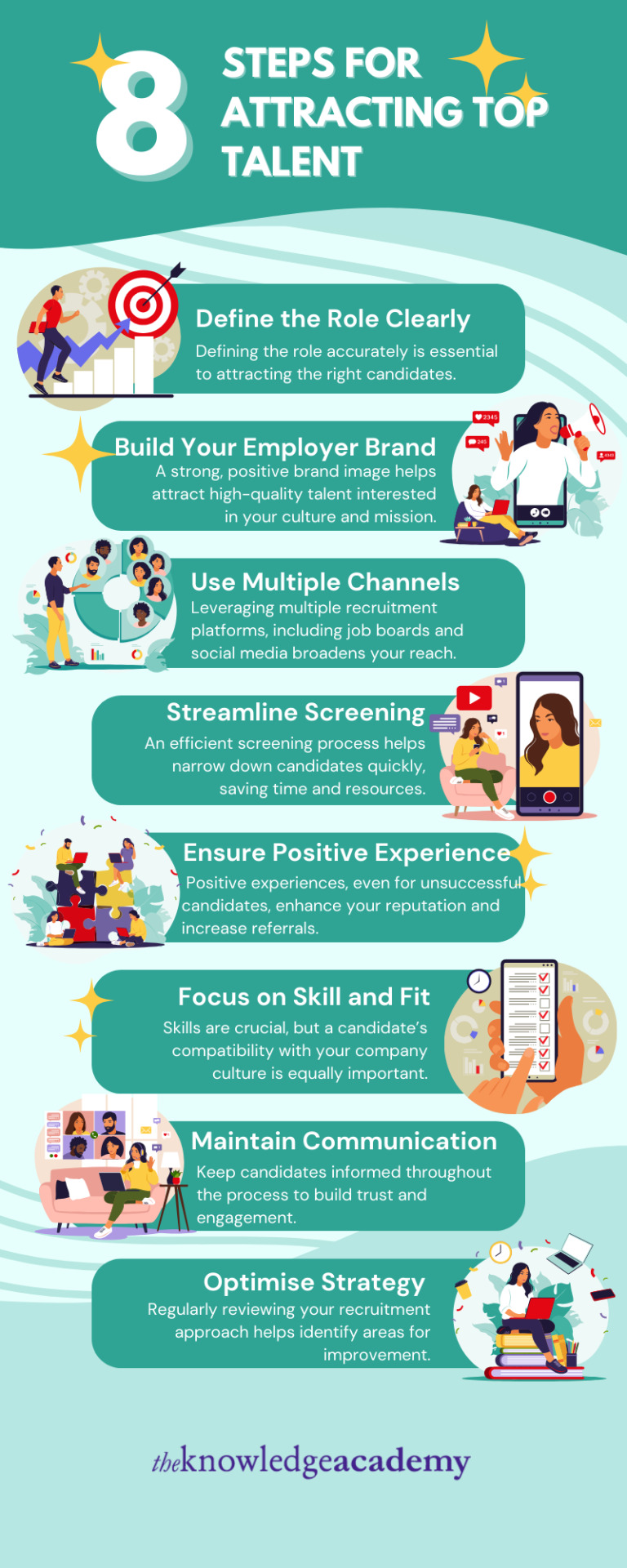
Effective recruitment is crucial for building a cohesive, high-performing team. This roadmap to recruitment success covers key steps, starting with clear role definitions and a strong employer brand, which attract the right candidates who resonate with company values. Utilising multiple channels, like job boards and social media, expands reach, while an efficient screening process identifies the best talent. Ensuring a positive candidate experience is vital, as it leaves a lasting impression and enhances your brand's reputation. Balancing skill with cultural fit is essential, as it promotes long-term success and job satisfaction for both parties. Open communication throughout the process builds trust and engagement, keeping top candidates interested. Regularly evaluating and refining recruitment strategies help improve future hires and adapt to evolving needs. For those wanting to master these techniques, Recruitment Courses offer valuable insights, guiding HR professionals in building strong, effective recruitment practices that lead to a dedicated, thriving workforce.
0 notes
Text
Crafting Stories That Stick: A Beginner’s Guide to Creative Writing
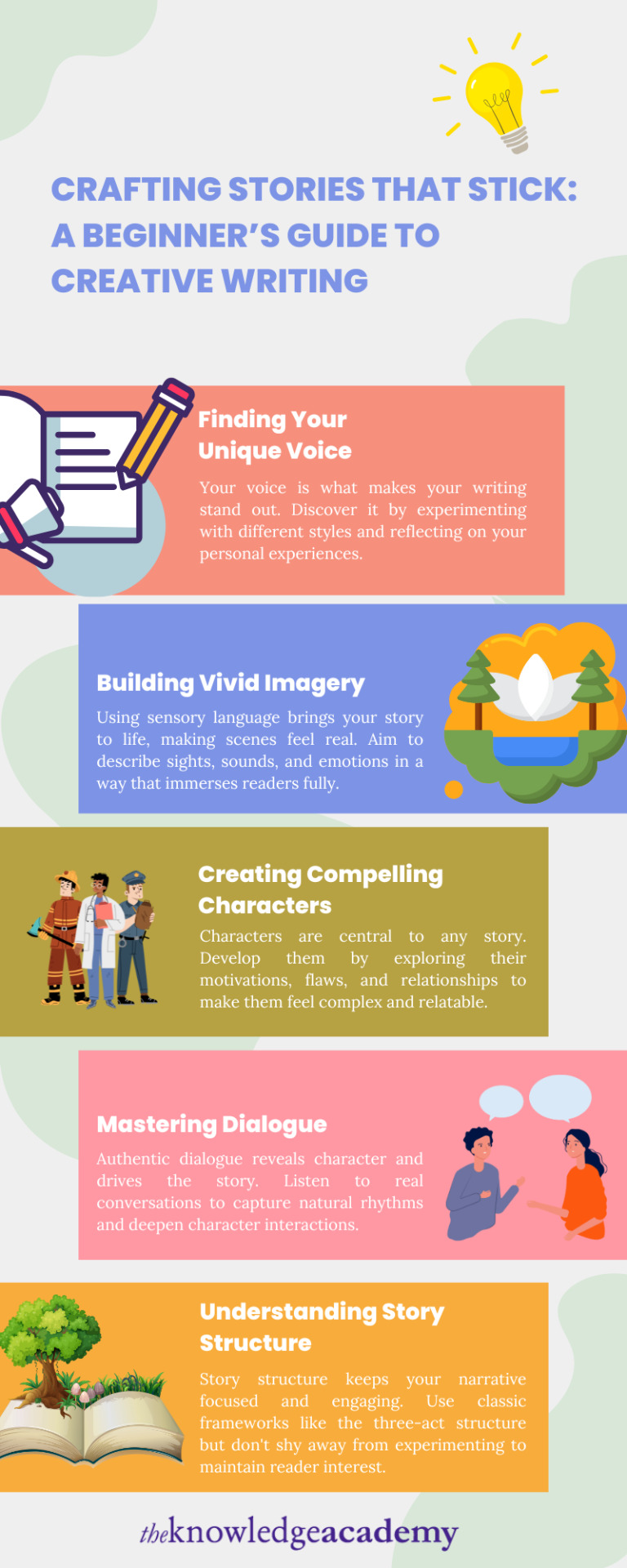
Creative writing is the art of weaving imagination and technique to produce stories that captivate, inspire, and resonate. It blends creativity with a clear structure, helping writers bring their unique voice to life on the page. A Creative Writing Course offers invaluable insights and practical guidance, covering everything from crafting vivid imagery to developing complex characters. In such a course, writers refine their skills by mastering essential elements like dialogue, pacing, flow, and story arcs, all of which make their narratives more impactful. By gaining a deep understanding of story structure and character depth, writers can create emotionally resonant work that draws readers into immersive worlds. For writers of all levels, a structured Creative Writing Course can be a transformative experience, enhancing storytelling abilities, fostering self-expression, and building a lasting connection with readers. It’s an essential tool for anyone looking to elevate their writing craft and create meaningful, memorable stories.
0 notes
Text
Understanding Blockchain: The Technology Transforming Industries
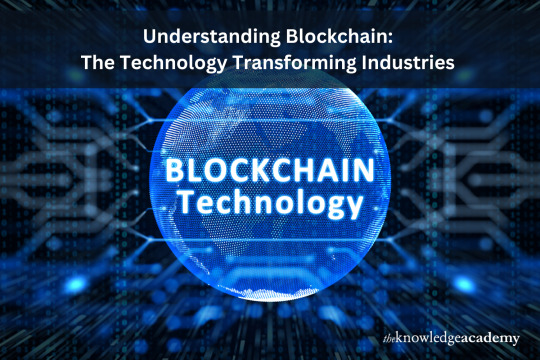
Blockchain is often considered one of the most revolutionary technologies of the 21st century, with applications far beyond cryptocurrency. From healthcare to supply chain management, this decentralised, secure, and transparent technology is being adopted by various sectors. With the growing importance of blockchain, there’s a high demand for professionals who understand this technology—making Blockchain Courses an essential stepping stone for anyone looking to enter or advance in this field. Let’s delve into what blockchain is, why it’s so impactful, and how it’s changing the way businesses operate.
What is Blockchain?
At its core, blockchain is a distributed ledger technology. Unlike traditional databases, where information is stored in a centralised system, blockchain uses a decentralised network of computers (or nodes) to validate and record data in “blocks.” Each block is linked to the one before it, creating an unalterable chain of information. This structure makes it nearly impossible to tamper with data, enhancing security and trust.
The decentralised nature of blockchain means that no single authority controls the data, which allows for transparency. Once data is recorded on a blockchain, it cannot be easily altered, ensuring the integrity of the information. This makes blockchain a trusted solution for applications where data accuracy and transparency are paramount, such as financial transactions, healthcare records, and identity verification.
Key Features of Blockchain
Blockchain’s unique structure and security features make it an ideal choice for various applications. Here are a few of its defining characteristics:
Decentralisation: Unlike traditional systems, blockchain operates on a network of nodes, making it resistant to data breaches and censorship.
Transparency: All participants in a blockchain network can view transactions, making it easy to track data changes and build trust.
Immutability: Once a block is added, it cannot be altered, which makes blockchain especially useful for maintaining accurate historical records.
Security: Blockchain uses cryptographic hashing, ensuring data is securely stored and protected from tampering.
Smart Contracts: Many blockchains support smart contracts—self-executing contracts with the terms directly written into code. This eliminates intermediaries and speeds up processes.
Applications of Blockchain Across Industries
Blockchain technology’s impact reaches across multiple industries. Below are some examples of how it is used:
1. Finance and Banking
Blockchain’s origins lie in cryptocurrency, with Bitcoin being its first successful application. Beyond cryptocurrency, blockchain is transforming the financial sector by enabling faster and more secure transactions. Traditional financial transactions often require intermediaries, adding time and cost. Blockchain’s decentralised structure allows for instant transactions without middlemen, reducing costs and enhancing security.
2. Supply Chain Management
In supply chain management, transparency and traceability are essential. Blockchain enables businesses to track products from production to delivery. By recording each step of a product’s journey on an immutable ledger, companies can verify the origins and authenticity of goods, reducing fraud and improving supply chain efficiency.
3. Healthcare
In healthcare, patient records and data privacy are paramount. Blockchain’s secure, decentralised structure allows patient data to be shared across healthcare providers while maintaining privacy. This ensures that records are accurate, accessible, and secure, improving patient outcomes and reducing administrative costs.
4. Real Estate
Blockchain simplifies the often-complicated process of buying and selling property. By recording property transactions on a blockchain, it is easier to verify ownership, reduce fraud, and streamline the transfer process. Smart contracts can also automate parts of the buying process, saving time and reducing the need for intermediaries.
5. Voting and Governance
Blockchain has potential in secure voting systems. By recording votes on a blockchain, election authorities can ensure transparency and prevent tampering. This technology provides a verifiable and secure way to conduct elections, which is especially relevant in regions where voter fraud is a concern.
The Future of Blockchain and Emerging Trends
As blockchain technology evolves, new trends and applications are emerging. Some notable trends include:
Interoperability: Efforts are underway to enable different blockchains to communicate with each other, creating a more connected and versatile ecosystem.
Decentralised Finance (DeFi): DeFi uses blockchain to create financial products that operate without traditional banks. It includes lending, borrowing, and trading platforms that function entirely on decentralised networks.
Non-Fungible Tokens (NFTs): NFTs represent ownership of unique digital items like art, music, and collectibles. They are stored on a blockchain, providing a way to verify the authenticity of digital assets.
Green Blockchain: Concerns about blockchain’s energy consumption are driving innovation in energy-efficient blockchain systems, such as Proof of Stake (PoS) rather than the more energy-intensive Proof of Work (PoW).
The Demand for Blockchain Skills
As blockchain becomes more integrated into mainstream industries, there is a growing need for professionals with blockchain expertise. Skills in blockchain development, smart contract programming, and understanding blockchain security protocols are in high demand. Many businesses are looking for individuals who can help them implement blockchain technology to streamline processes, increase transparency, and secure data.
Blockchain Courses are now more accessible than ever, with options ranging from introductory courses to advanced certifications. For anyone interested in blockchain’s potential and applications, these courses provide the foundational knowledge and practical skills needed to work in this exciting field.
Conclusion
Blockchain is more than just a buzzword—it’s a transformative technology that is reshaping industries, enhancing security, and fostering transparency. From finance to healthcare, its applications are vast and varied, promising to streamline processes and reduce fraud across sectors. With the demand for blockchain professionals growing, now is an ideal time to learn more about this technology and explore Blockchain Courses to build expertise.
By understanding blockchain’s fundamentals and applications, professionals can position themselves at the forefront of this technological revolution, making them valuable assets in an increasingly digital world.
0 notes
Text
A Beginner’s Roadmap to R Programming for Data Analysis

If you’re interested in data analysis, statistics, or machine learning, you’ve likely heard about R programming. R is a powerful language widely used for statistical computing and graphics, making it the go-to tool for data scientists, statisticians, and researchers. Whether you’re completely new to programming or looking to broaden your skill set, taking an R Programming Course is an excellent way to dive into this versatile language and harness the power of data manipulation and analysis.
What is R Programming?
R is an open-source programming language and software environment designed specifically for statistical computing and graphics. Initially developed by statisticians Ross Ihaka and Robert Gentleman in 1993, R has since grown into one of the most widely used programming languages for data analysis. What sets R apart is its ability to handle complex statistical computations and generate high-quality visualisations with just a few lines of code.
One of R's greatest strengths is its active community, which continuously develops new packages to extend the language’s capabilities. This makes R not just a language but a comprehensive toolset for solving various data problems, ranging from basic descriptive statistics to advanced machine learning algorithms.
Key Features of R:
Statistical analysis: R excels at handling large datasets and performing sophisticated statistical analysis. Whether it's regression models, hypothesis testing, or time series analysis, R can manage it all.
Data visualisation: With libraries like ggplot2 and plotly, R makes creating compelling, interactive visualisations simple. You can generate anything from bar charts to complex 3D plots.
Open-source: Like Python, R is free to use and supported by a large, vibrant community. New packages are constantly being added, expanding R’s functionality.
Cross-platform compatibility: R works on multiple operating systems including Windows, macOS, and Linux, making it accessible to a wide range of users.
Why Learn R?
R is particularly valuable for professionals working in data-heavy industries such as finance, healthcare, academia, and marketing. If you’re dealing with numbers, learning R can offer a tremendous advantage. From predictive modeling to customer segmentation, R allows users to analyse, visualise, and present data efficiently.
Here are a few reasons why learning R should be on your radar:
Data Science and Analytics: R is a favourite among data scientists because of its range of statistical packages. If you plan on pursuing a career in data science, mastering R can help you understand and interpret data more effectively.
Machine Learning: R’s extensive machine learning libraries make it easier to train models, evaluate their performance, and predict outcomes. Popular packages like caret and randomForest offer tools for building robust machine learning models with minimal effort.
Big Data: R integrates well with Hadoop and Spark, enabling users to analyse massive datasets. This feature is invaluable for companies that generate huge volumes of data every day.
High-Quality Visualisation: Whether you’re preparing a presentation for stakeholders or publishing research, R’s visualisation libraries are essential for turning raw data into readable, meaningful insights.
Academic Research: R is heavily used in academia for research projects involving data collection, analysis, and interpretation. Its ability to handle large datasets with complex statistical techniques makes it indispensable in this field.
Practical Applications of R
Data Cleaning and Preprocessing: Data is often messy, with missing values, outliers, and inconsistencies. R offers packages like dplyr and tidyr to clean, organise, and transform your data, preparing it for analysis.
Exploratory Data Analysis (EDA): Before diving into complex algorithms, R allows you to understand your dataset through exploratory data analysis. With functions that compute descriptive statistics, correlations, and create graphs, you’ll quickly gain insight into trends and patterns in your data.
Machine Learning and AI: With R, building machine learning models is straightforward. Popular algorithms like decision trees, random forests, and neural networks are supported with just a few lines of code, making model training and evaluation accessible even to beginners.
Advanced Data Visualisation: R enables users to create professional-grade visualisations using libraries like ggplot2. You can customise your plots, making them suitable for anything from business reports to academic publications.
Statistical Modelling: R is particularly strong in statistical modelling, providing tools to conduct regression analysis, hypothesis testing, and ANOVA (Analysis of Variance). It is frequently used in sectors where statistical rigor is paramount, such as healthcare and finance.
Why Enrol in an R Programming Course?
While there are many free resources available to get started with R, a structured R Programming Course offers a comprehensive path from beginner to advanced levels. You’ll not only learn the fundamentals but also develop the skills needed to work on real-world data projects. A well-structured course typically covers:
Basic Syntax and Functions: Learn how to use R’s simple syntax to perform calculations, create variables, and call functions.
Data Structures: Understand R’s data structures like vectors, matrices, lists, and data frames, which are crucial for handling datasets.
Data Manipulation: Master essential packages like dplyr and tidyr to filter, group, and summarise data.
Statistical Analysis: Learn how to perform complex statistical analysis such as t-tests, chi-square tests, and regression analysis.
Data Visualisation: Gain proficiency in creating data visualisations using ggplot2 and other popular libraries.
Advanced Topics: Explore machine learning, text mining, and time series analysis to become proficient in handling a variety of data tasks.
How to Get Started with R
Download R: Start by downloading R from the official site (https://www.r-project.org/) and install RStudio, a popular IDE that makes it easier to write and execute your code.
Familiarise Yourself with RStudio: RStudio provides a user-friendly environment for coding in R, featuring syntax highlighting, debugging tools, and workspace management.
Learn Through Practice: Once you have the basic setup, start practicing with simple datasets. The more hands-on experience you gain, the easier it will be to grasp complex concepts.
Join the R Community: Engage with R’s active community through online forums, GitHub, or Stack Overflow. These platforms offer a wealth of knowledge, tips, and support for beginners and advanced users alike.
Work on Projects: As you gain confidence, begin working on small projects such as analysing datasets from Kaggle or even your personal data (e.g., fitness tracking or financial records). This will give you a deeper understanding of how R can be applied in practical scenarios.
Conclusion: R Programming in the Modern World
R programming remains a fundamental tool for anyone serious about data analysis and visualisation. Its ease of use, combined with the sheer number of packages available, makes it an ideal choice for professionals across various industries. Enrolling in an R Programming Course can be the perfect way to gain a structured understanding of the language, from basic syntax to advanced machine learning models. Whether you're pursuing a career in data science, academic research, or business analytics, mastering R will equip you with the skills to unlock insights from data and make informed decisions.
0 notes
Text
Building the Future: Key Elements of Modern Construction

The construction industry is undergoing significant transformations, with sustainability, technology, safety, skilled labour, and smart buildings at the forefront. The use of sustainable materials such as recycled steel and bamboo is helping to reduce the environmental impact of new projects. Meanwhile, innovative technologies like 3D printing and drones are reshaping how buildings are designed and constructed, offering enhanced accuracy and efficiency. Safety remains a top priority, with advancements such as wearable sensors improving worker protection. Despite the rise of automation, a skilled workforce continues to be critical for bringing creativity and expertise to modern projects. Finally, the development of smart buildings is revolutionising the industry, focusing on energy efficiency, automation, and user-centric designs. As cities grow, urban planners are incorporating these smart buildings to improve liveability and sustainability. The future of construction is being shaped by a balance of tradition and innovation, and pursuing a Construction Management Course can equip professionals with the skills needed to lead projects in this evolving landscape.
0 notes
Text
Defusing Disagreements: Conflict Management Skills for Success
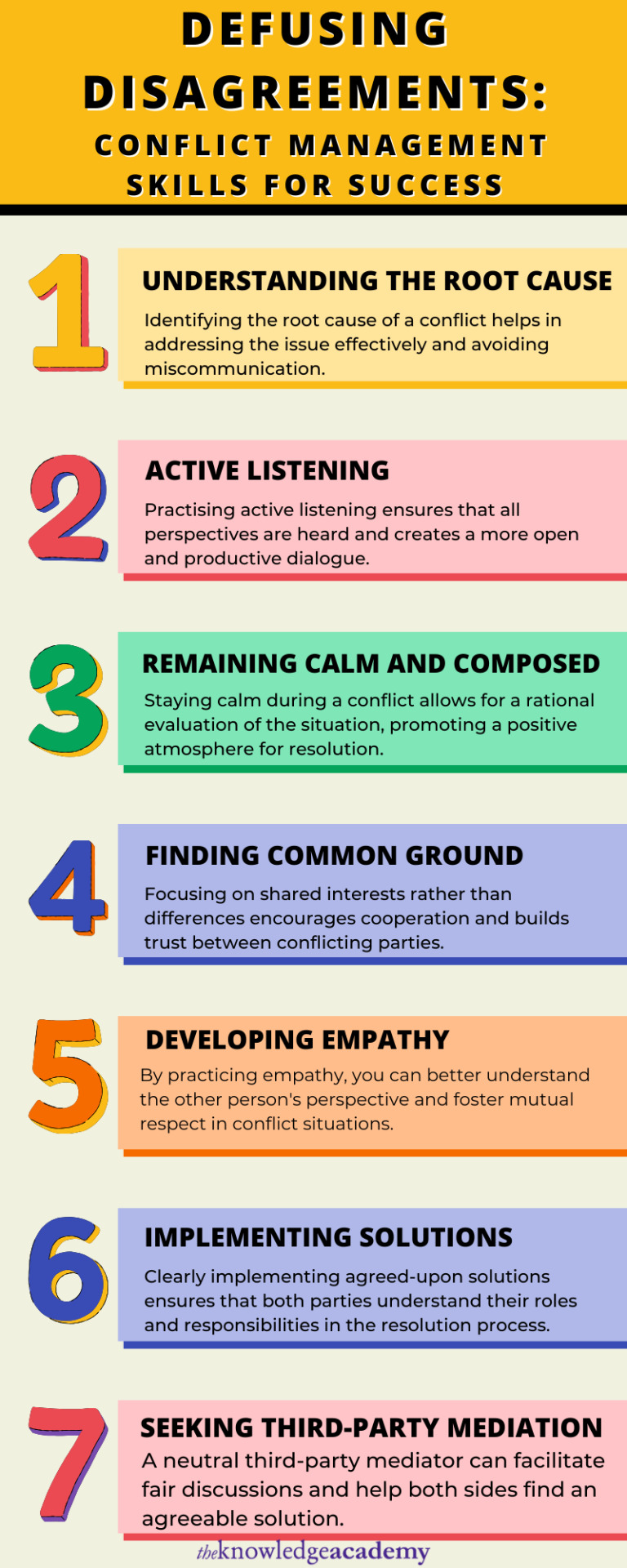
Conflict is an unavoidable part of life, whether in the workplace or personal relationships. However, mastering the skills to manage conflict effectively can transform a potentially disruptive situation into an opportunity for growth. Conflict management begins with identifying the root cause, which allows for a better understanding of the situation. Active listening is equally important, ensuring all parties feel heard, and fostering an open environment for discussion. Maintaining calm and seeking common ground helps prevent escalation and encourages constructive dialogue. Empathy plays a crucial role by helping individuals understand different perspectives, which promotes respect and cooperation. Once a resolution is reached, implementing the solution effectively ensures lasting peace. In cases where conflicts are particularly complex, third-party mediation can offer a balanced approach to resolution. For those looking to improve their conflict-handling skills, Conflict Management Training provides invaluable techniques to navigate disagreements, reducing stress and enhancing productivity. This training helps individuals turn conflict into a tool for positive change, fostering stronger relationships and better outcomes.
0 notes
Text
Mastering the Art of Creative Writing
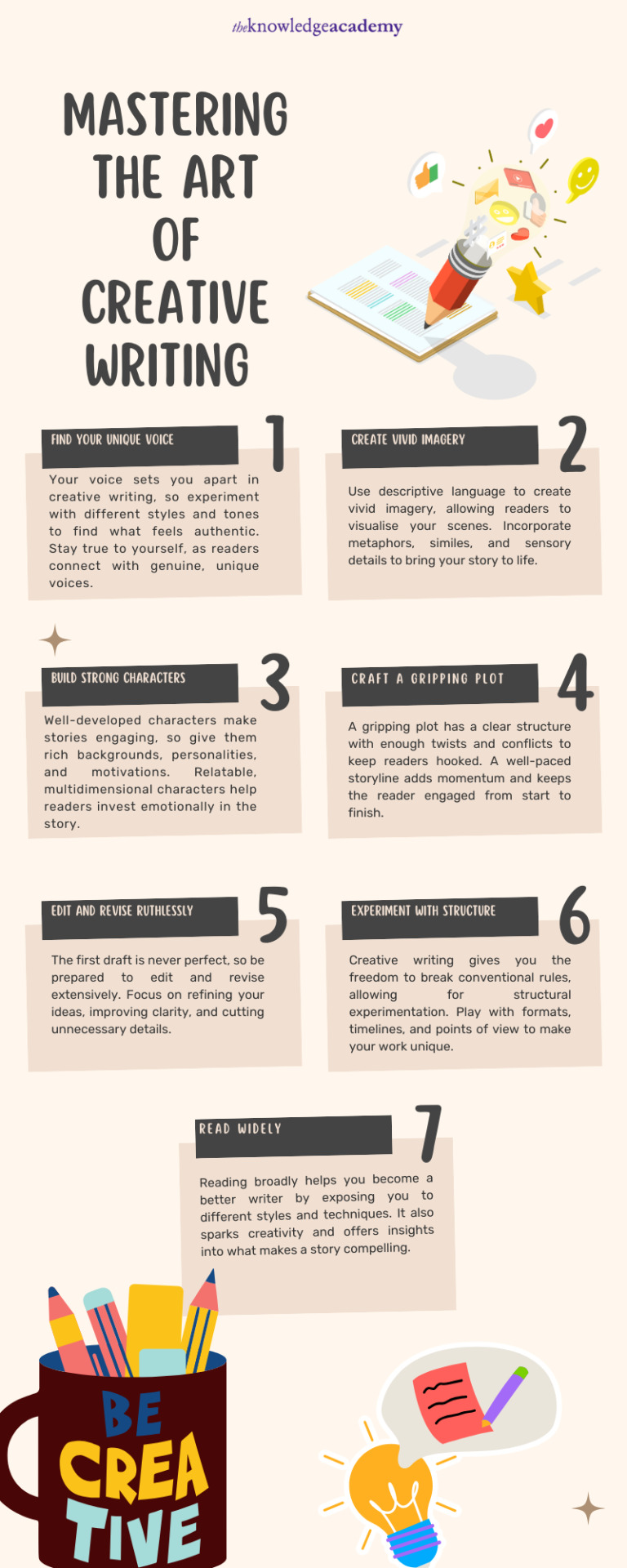
If you're looking to improve your writing skills, taking a Creative Writing Course can be an excellent way to hone your craft. This infographic explores seven essential tips that can elevate your creative writing, from finding your unique voice to crafting vivid imagery and well-rounded characters. The journey to becoming a skilled writer involves continual editing and experimenting with structure, but most importantly, reading widely to fuel your imagination. Whether you're writing fiction, poetry, or essays, mastering these elements will help you engage your readers and develop a distinctive storytelling style. A Creative Writing Course can provide the tools and techniques to further refine your abilities, allowing you to write with more confidence and creativity.
0 notes
Text
5 Essential Steps to Successful Product Management
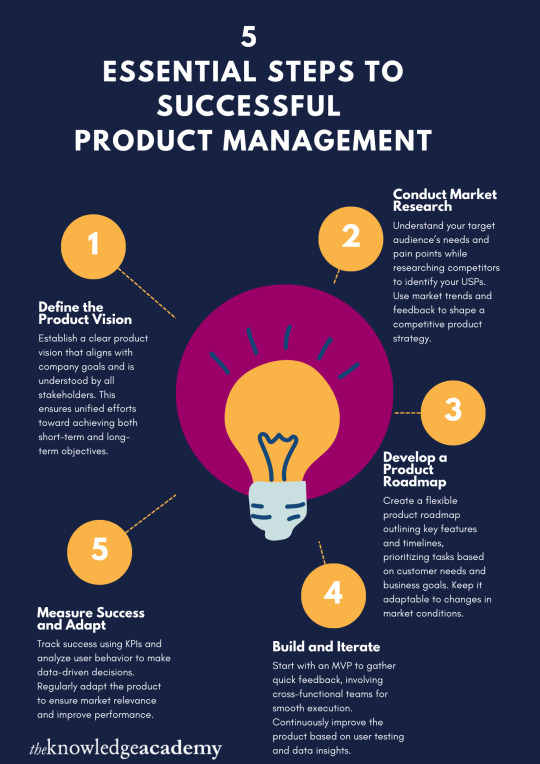
Successful product management involves a structured approach to ensure a product meets market needs and business goals. The first step is to define a clear product vision that aligns with company objectives and is well understood by all stakeholders. This creates a unified direction for the team. Conducting thorough market research is essential for understanding target audience needs and competitor positioning, which helps in crafting a strong product strategy. Next, a flexible product roadmap is developed, outlining key features and timelines, while remaining adaptable to market changes. Building the product starts with a Minimum Viable Product (MVP) to gather quick feedback, with cross-functional team involvement ensuring smooth execution. Product Management Training can enhance skills in these areas by teaching how to track a product's success, using key performance indicators (KPIs) and user feedback. Regular iteration and adaptation of the product ensure it remains relevant and competitive, maximizing its long-term success in the market.
0 notes
Text
Proofreading: A Vital Skill for Clear Communication
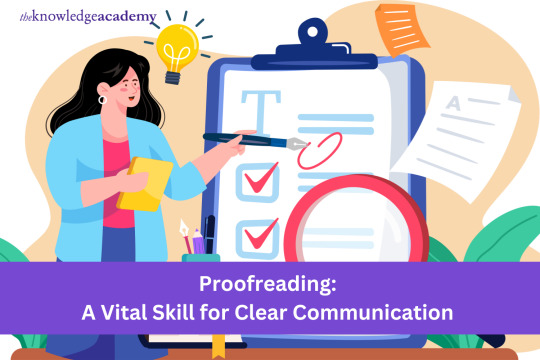
In today’s fast-paced, content-driven world, the demand for accuracy and clarity in written communication has never been more important. Whether it’s a business report, an academic paper, or a social media post, polished content makes a lasting impression. This is where proofreading comes in. A well-rounded Proofreading Course can equip you with the skills to identify and correct errors that might otherwise slip through the cracks.
Proofreading involves reviewing and correcting written content to ensure it’s free from grammatical, spelling, punctuation, and formatting errors. It’s the final step in the editing process, and it guarantees that a document is polished and professional. While some may view it as a quick skim, the art of proofreading requires attention to detail, knowledge of language mechanics, and a methodical approach to review content.
Why Proofreading Matters
Proofreading is essential for anyone who communicates through written words. Whether you’re a student submitting a thesis, a marketer drafting a product description, or an executive preparing a report, errors can undermine your credibility. Here’s why proofreading matters:
First Impressions Count: Grammatical errors and typos can distract your audience, making them focus more on your mistakes than your message.
Clarity and Readability: Proofreading ensures your content is easy to understand and free of ambiguities that may confuse the reader.
Professionalism: Flawless writing demonstrates professionalism, helping to build trust with your audience or clients.
The Proofreading Process: Step-by-Step
Proofreading is a structured process, often broken down into several stages to ensure no errors are missed. Here’s a look at the typical steps involved:
1. Initial Read-through
Start by reading the entire document to get a sense of the flow, tone, and structure. This first pass allows you to familiarize yourself with the content before diving into corrections.
2. Check for Grammar and Syntax Errors
Next, review the document for grammar, punctuation, and syntax mistakes. These may include misplaced commas, sentence fragments, subject-verb agreement issues, or incorrect word usage. Tools like spell check can be helpful, but nothing beats a human eye for catching complex errors.
3. Look for Consistency
Ensure consistency in style, tone, and formatting throughout the document. For example, if you’re proofreading a business document, check that bullet points, headings, and fonts are consistent. Consistency improves readability and enhances the professionalism of the content.
4. Fact-checking
If your content includes data, dates, names, or references, it’s crucial to verify that everything is accurate. This step is especially important for academic papers or business reports, where even minor factual errors can lead to credibility issues.
5. Check for Formatting and Layout Issues
A document’s layout is just as important as its text. Ensure that the formatting is clean, paragraphs are aligned correctly, and there are no awkward breaks between sections. Proper formatting contributes to readability and makes your content more accessible to your audience.
6. Final Read-through
Once you’ve addressed the major issues, conduct a final read-through. This pass should focus on the overall readability of the document, ensuring that the flow is smooth and the content is error-free.
Key Skills for Effective Proofreading
A proofreading course can teach you more than just the mechanics of grammar and punctuation. It hones essential skills like attention to detail, patience, and critical thinking. Below are some of the key skills needed to excel at proofreading:
Attention to Detail: Proofreading requires spotting even the tiniest errors, whether they’re misplaced commas or extra spaces.
Concentration: You need to focus for extended periods, especially when proofreading long documents.
Grammar and Language Mastery: A solid understanding of language rules is critical to ensure the content is both error-free and stylistically correct.
Time Management: Proofreading on a tight deadline requires effective time management to balance speed with accuracy.
The Difference Between Proofreading and Editing
Many people confuse proofreading with editing, but they are distinct stages in the writing process. Editing involves making changes to improve the overall structure, clarity, and flow of a document. It’s more in-depth and may involve reorganizing sections, rewriting sentences, or refining ideas.
Proofreading, on the other hand, focuses on the surface-level details, such as typos, grammatical errors, and formatting. It’s the final stage that ensures the document is polished and ready to be published or submitted.
Benefits of Taking a Proofreading Course
Learning how to proofread efficiently is a skill that can be developed with practice and guidance. Taking a proofreading course offers the following benefits:
Enhanced Skill Set: A course will teach you various proofreading techniques, from spotting grammatical errors to ensuring layout consistency.
Increased Career Opportunities: Proofreading is a highly sought-after skill in fields like publishing, content creation, marketing, and education.
Attention to Detail: You'll develop an eye for detail, which is invaluable in any professional setting.
Practical Application: Many courses offer real-world assignments, allowing you to apply what you’ve learned in a practical context.
How to Choose the Right Proofreading Course
When selecting a proofreading course, it’s important to consider your specific needs and goals. Here are a few factors to keep in mind:
Course Content: Look for courses that cover grammar, punctuation, style consistency, and formatting.
Instructor Experience: Opt for a course led by experienced proofreaders or editors who can offer practical insights.
Certification: Some courses offer certifications upon completion, which can boost your resume and make you more marketable to potential employers.
Flexibility: Choose a course that fits your schedule, whether it’s self-paced or instructor-led.
Proofreading Tools to Consider
While a proofreading course will sharpen your skills, there are also several tools you can use to make the process easier:
Grammarly: A popular grammar and spell checker that also offers stylistic suggestions.
Hemingway Editor: This tool focuses on readability and suggests ways to simplify complex sentences.
ProWritingAid: A comprehensive writing assistant that checks for grammar, style, and consistency.
Google Docs Spell Checker: Basic but effective for spotting simple spelling and grammatical mistakes.
Conclusion
Proofreading is an essential skill for anyone who communicates through written words. It ensures that your content is clear, professional, and free from distracting errors. Whether you’re looking to refine your skills or pursue a career in proofreading, taking a proofreading course can offer the training and insights you need to succeed. By mastering the art of proofreading, you can improve your writing, enhance your credibility, and open doors to new career opportunities.
Isn't it time to take your proofreading skills to the next level?
0 notes
Text
5 Essential Skills for Effective Negotiation
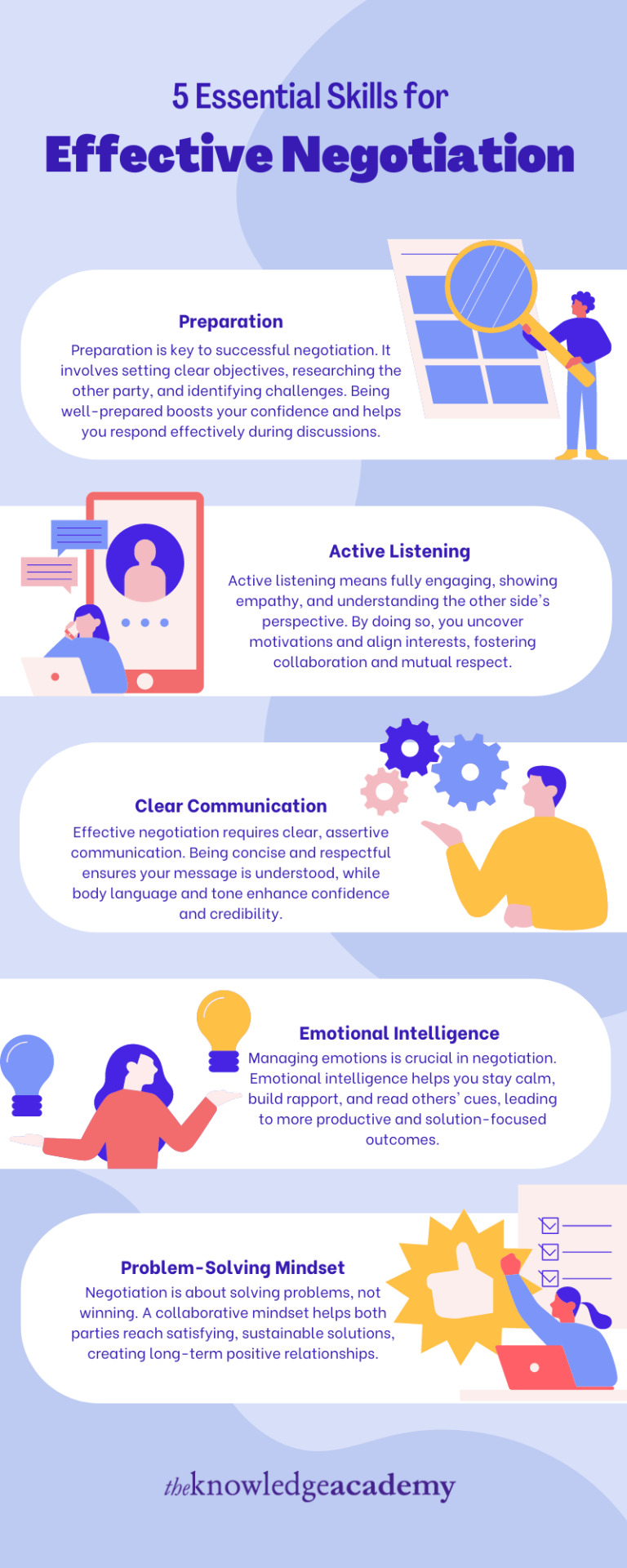
Negotiation skills are essential in both personal and professional settings, and mastering them can significantly influence your success. These skills can be learned and developed through dedicated Negotiation Skills Training, which helps individuals enhance their ability to prepare, listen actively, communicate clearly, and manage emotions during negotiations. Negotiators who are well-prepared and skilled in emotional intelligence are more likely to create mutually beneficial outcomes. Active listening and clear communication help in understanding the other party’s perspective, while a problem-solving approach ensures long-term, collaborative relationships. Investing time in Negotiation Skills Training enables you to navigate complex discussions with confidence, secure better deals, and resolve conflicts efficiently. This valuable training can empower you to negotiate successfully in a variety of contexts, from business deals to salary discussions and personal relationships.
0 notes
Text
Top Benefits of Using R Programming in Data Science

R Programming stands out as a powerful tool in data science due to its open-source nature, making it freely accessible and constantly updated by a vibrant community. It is renowned for its exceptional data visualisation capabilities, using libraries like ggplot2 to create highly customisable and insightful graphs. With over 15,000+ packages available, R offers a vast ecosystem that supports tasks ranging from data manipulation to machine learning, making it highly versatile. Its strong statistical modelling capabilities allow users to perform everything from simple statistical tests to advanced predictive modelling, making it ideal for a range of applications. R also excels in handling large datasets efficiently and integrates smoothly with platforms like SQL and Hadoop, which is crucial in big data environments. Additionally, the active R community ensures ample support through forums, tutorials, and documentation. Taking an R Programming Course can be an excellent way to master these features, providing structured learning to build expertise. The language’s ability to seamlessly integrate with other tools like Python and Tableau further enhances its flexibility in diverse workflows.
0 notes
Text
7 Essential Elements of Creative Writing

Creative writing thrives on originality, encouraging writers to push boundaries and develop fresh, unique ideas. Strong, multi-dimensional characters with distinct goals, flaws, and emotions help readers form connections with the story. A gripping plot is crucial, with a clear beginning, middle, and end, as well as rising tension and conflicts that add intrigue and keep the audience engaged. The setting plays a vital role, enhancing the mood and atmosphere, while immersing readers in the world you have created. Dialogue should sound natural and authentic, revealing characters’ personalities and moving the plot forward effectively. A key principle in creative writing is "show, don’t tell" — using sensory details, actions, and vivid descriptions to allow readers to experience the story firsthand, rather than simply being told what happens. Finally, refining the story through thorough editing is essential. Revising the structure, grammar, and flow, while cutting unnecessary details, helps to strengthen the narrative. A Creative Writing Course can help you master these crucial skills.
0 notes
Text
Practical Ways to Improve Pronunciation
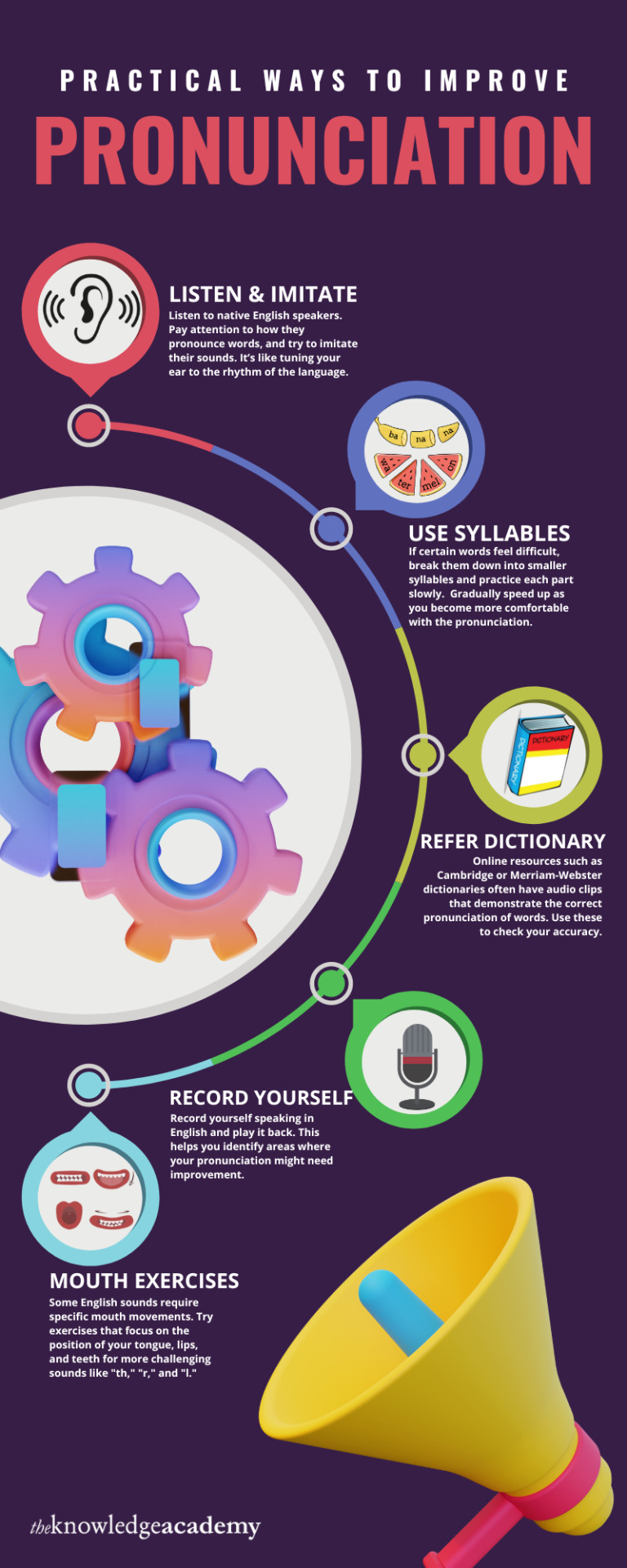
To improve pronunciation in English, several practical strategies can be highly effective. Start by listening to native speakers through movies, podcasts, or audiobooks, and imitate their pronunciation to attune your ear to the language's rhythm. For challenging words, break them down into syllables and practice slowly before gradually increasing your speed. Online resources like Cambridge or Merriam-Webster dictionaries offer pronunciation guides with audio clips that can help you refine your accuracy. Another useful technique is recording yourself while speaking in English and comparing it to a native speaker’s version to identify areas for improvement. Additionally, mouth exercises focusing on tongue, lip, and teeth movements can help with more difficult sounds like "th," "r," and "l." These methods are often incorporated into an English Speaking Course, providing structured guidance to learners looking to enhance their pronunciation skills.
1 note
·
View note